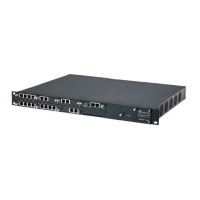Version 6.2 405 February 2011
SIP User's Manual 8. IP Telephony Capabilities
8 IP Telephony Capabilities
This section describes the device's main IP telephony capabilities.
8.1 Multiple SIP Signaling and Media Interfaces
The device supports multiple, logical SIP signaling interfaces and RTP (media) traffic
interfaces. This allows you to separate SIP signaling messages and media traffic between
different applications (i.e., SAS, Gateway\IP-to-IP, and SBC), and/or between different
networks (e.g., when operating with multiple ITSP's). Multiple SIP signaling and RTP
interfaces are configured using Signaling Routing Domains (SRD), as described in
''Signaling Routing Domains'' on page 405.
For
an example configuration of multiple SIP signaling and media interfaces, see ''Multiple
SIP Signaling and Media Configuration Example'' on page 408.
8.1.1 Signaling Routing Domains
A Signaling Routing Domain (SRD) is a set of definitions of IP interfaces, device resources,
SIP behaviors and other definitions that together create (from the IP user's perspective)
multiple, virtual multi-service gateways from one physical device.
An SRD is composed of the following:
Media Realm: The Media Realm defines a media port range associated with a Media
IP interface (defined in the Multiple Interface table in ''Configuring IP Interface
Settings'' on page 83). Me
dia Realms are defined in the SIP Media Realm table (see
''Media Realms'' on page 406) a
nd then later assigned to an SRD (in the SRD table).
SIP Interface: A SIP signaling interface is a combination of UDP, TCP, and TLS ports
associated with a specific IP address (network interface, configured in the Multiple
Interface table). SIP Interfaces are defined n the SIP Signaling Interface table (see
''SIP Interfaces'' on page 406)
where they are also assigned to specific SRDs.
Once configured, you can use an SRD as follows:
Associate it with a SIP Interface (see ''Configuring SIP Interface Table'' on page 117)
Asso
ciate it with an IP Group (see Configuring IP Groups on page 119)
Asso
ciate it with a Proxy Set (see Configuring Proxy Sets Table on page 126)
Apply an Admissi
on Control rule to it (see Configuring Admission Control Table on
page 195)
Define it as a
Classification rule for the incoming SIP request (see Configuring
Classification Table on page 198)
Define it as a
destination IP-to-IP routing rule (see ''Configuring IP-to-IP Routing
Table'' on page 201)
SRD provides the followi
ng capabilities:
Multiple, different SIP signaling (SRD associated with a SIP Interface, described later)
and RTP media (associated with a Media Realm) interfaces for multiple Layer-3
networks. Due to the B2BUA nature of the SBC application, different interfaces can be
assigned to each leg of the call, and between the LAN side and the WAN side.
Ability to operate with multiple gateway customers that may reside either in the same
or in different Layer-3 networks as the device. This allows separation of signaling

